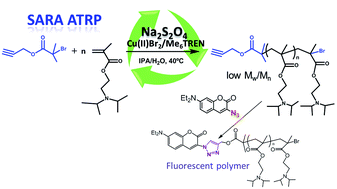Synthesis of well-defined functionalized poly(2-(diisopropylamino)ethyl methacrylate) using ATRP with sodium dithionite as a SARA agent†
Abstract
2-(Diisopropylamino)ethyl methacrylate (DPA) was polymerized by Atom Transfer Radical Polymerization (ATRP) using sodium dithionite (Na2S2O4) as a reducing agent and supplemental activator with a Cu(II)Br2/Me6TREN catalytic system at 40 °C in an isopropanol–water mixture. The effects of the solvent mixture and the initiator structure on the polymerization kinetics were studied. The eco-friendly catalytic system described is suitable for the synthesis of poly(2-(diisopropylamino)ethyl methacrylate) (PDPA) with controlled molecular weight, low dispersity, and well-defined chain-end functionality. Both linear and 4-arm star polymers with various target molecular weights were synthesised. The 1H NMR and MALDI-TOF analyses confirmed the molecular structure and high chain-end functionality of the obtained polymers. The use of an alkyne functionalized initiator allowed further azide–alkyne Huisgen cycloaddition with 3-azido-7-diethylamino-coumarin, a fluorescent biocompatible molecule.


 Please wait while we load your content...
Please wait while we load your content...